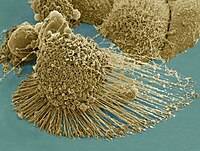
Photo from wikipedia
Background Polyamines are involved in several cellular processes and inhibiting their synthesis affects chikungunya virus (CHIKV) replication and translation, and, therefore, reduces the quantity of infectious viral particles produced. In… Click to show full abstract
Background Polyamines are involved in several cellular processes and inhibiting their synthesis affects chikungunya virus (CHIKV) replication and translation, and, therefore, reduces the quantity of infectious viral particles produced. In this study, we evaluated the inhibition of CHIKV replication by N-ω-chloroacetyl-L-ornithine (NCAO), a competitive inhibitor of ornithine decarboxylase, an enzyme which is key in the biosynthesis of polyamines (PAs). Methods The cytotoxicity of NCAO was evaluated by MTT in cell culture. The inhibitory effect of CHIKV replication by NCAO was evaluated in Vero and C6/36 cells. The intracellular polyamines were quantified by HPLC in CHIKV-infected cells. We evaluated the yield of CHIKV in titres via the addition of PAs in Vero, C6/36 cells and human fibroblast BJ treated with NCAO. Results We found that NCAO inhibits the replication of CHIKV in Vero and C6/36 cells in a dose-dependent manner, causing a decrease in the PFU/mL of at least 4 logarithms (p < 0.01) in both cell lines. Viral yields were restored by the addition of exogenous polyamines, mainly putrescine. The HPLC analyses showed that NCAO decreases the content of intracellular PAs, even though it is predominantly spermidines and spermines which are present in infected cells. Inhibition of CHIKV replication was observed in human fibroblast BJ treated with 100 μM NCAO 24 h before and 48 h after the infection at a MOI 1. Conclusions NCAO inhibits CHIKV replication by depleting the intracellular polyamines in Vero, C6/36 cells and human fibroblast BJ, suggesting that this compound is a possible antiviral agent for CHIKV.
Journal Title: Antiviral Therapy
Year Published: 2023
Link to full text (if available)
Share on Social Media: Sign Up to like & get
recommendations!